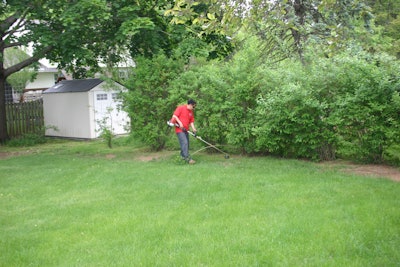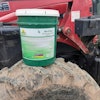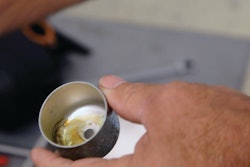
In the words of one of the most renowned small engine technicians of our time, Sling Blade, "It ain't got no gas in it." If only fixing your downed string trimmer were always that simple.
There are a few key things to look for when your crew brings a trimmer back to the shop and says, "It just isn't running right." First, the carburetor could be gummed up or shot altogether, which is becoming a bigger and bigger problem thanks to the havoc today's ethanol-blended fuels are wreaking on today's small engines. If you're lucky, though, the fuel filter or maybe even the air filter could be really dirty and in need of replacement.
There's one other thing you can check: the spark arrestor screen inside the muffler. That's the little doohickey that helps prevent sparks from flying out of the engine. Sometimes the spark arrestor screen can become clogged up itself. Common symptoms include lack of power, especially under load; poor acceleration; engine won't come up to full RPM; and higher than normal "spit back" through the carburetor.
To inspect the spark arrestor screen—when you sense a problem or otherwise monthly—refer to your string trimmer owner's manual for directions on how to access it. Once you get all the necessary screws out and covers off in order to access the screen, look it over.
"A blocked spark arrestor screen should be replaced," says Doug Peeler, Husqvarna's North American Technical Training Specialist and active member of the Equipment & Engine Training Council (EETC). "Every effort should be made to install a new screen before consideration is given to cleaning the existing one."
Screen cleaning tips
In the event that you can—and want to—simply clean the existing screen, Peeler offers some tips on how to properly do so.
Clamp the screen in a vise or hold with a pair of pliers.
Put some safety glasses and gloves on.
Use a small butane torch to burn the carbon off of the screen. Make sure there are no fuel, fuel vapors or other flammable materials within 20 feet. "Do not use a wire brush to clean the spark arresting screen," Peeler adds. "This causes the screen to become scratched. The scratches and rough surface of the screen then trap small carbon particles, causing accelerated plugging."
However, if some slight residue remains on the screen after torching it, Peeler says you can use a small non-metallic brush such as a toothbrush to finish cleaning it up—after it cools back down, of course.
Further considerations
Blocked screen. "A high amount of carbon and tar that builds up on the spark arresting screen causes a brown color to the piston," Peeler points out. "Piston ring jacking may also have already started to occur."
An almost totally blocked spark arrestor screen on a two-stroke, air-cooled engine can cause the engine to overheat. The result is that the piston expands into the exhaust port and the engine seizes.
- The piston scored because the engine was unable to dissipate heat fast enough.
- The piston shows heavy discoloration around the ring land area, due to the thermal breakdown of the oil.
- The piston ring stuck, allowing hot exhaust gases to blow past the ring.
- The blow-by overheated the piston and caused seizure.
A light tan to almost whitish color of the spark arrestor cover is a solid indication that the combustion temperatures became very high. "So, if you ever notice that the outside of the muffler is powdery whitish in appearance, it is a solid sign that the unit was badly overheated once during its lifetime," Peeler points out.
Missing screen. If the spark arrester screen is plugged or is missing, the muffler should be removed, and the exhaust port and combustion chamber must be inspected for deposits.
"The spark arrestor screen can be looked upon as an 'engine saver,'” Peeler says. "If the screen starts plugging, poor engine performance will usually cause the customer to bring the unit in for service or inspection. The cause of the screen plugging can be corrected by the technician, and the customer can be advised as to what caused it."
If the screen is removed, the carbon will start plugging the exhaust port. "Since the exhaust port cannot be seen by the customer, preventative maintenance will not be performed and the engine may fail, either due to overheating or carbon scoring," Peeler explains. "Carbon scoring is when a piece of carbon breaks off and becomes lodged between the piston and cylinder. The carbon scoring will usually start occurring when the exhaust port is blocked 60-70% or more."
Parting thought. "The spark arresting muffler screen is a very important part of a high-performance two-stroke, air-cooled engine," Peeler reminds. "Servicing of the screen at regular intervals will prolong the life of your two-stroke handheld product."




















